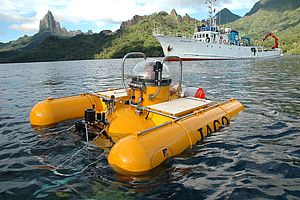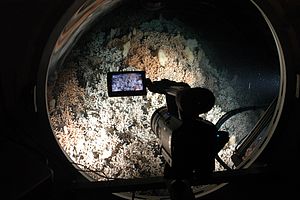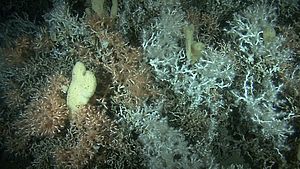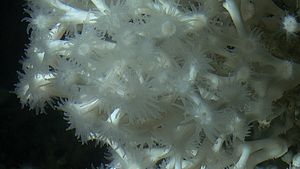The development of cold-water coral reefs and carbonate mounds, well known in Earth history, arose due to the discovery of living reef structures along the European continental margin as a prominent question in carbonate sedimentology. Our investigations focus on the provinces of the Porcupine Seabight, Rockall Troughs, and the Norwegian Margin, but also on occurrences in the Bay of Biscay and Gulf of Mexico. Here, reef mounds are mainly build by the scleractinian cold-water coral Lophelia pertusa providing diverse ecosystems of the deep shelf oceans and probably important breeding grounds for various fish species.
Carbonate mounds in the Porcupine Seabight, the Porcupine Bank and the Rockall Troughs occur in water depths between 500-1100 m. and are characterized by base diameters of 100-1800m and heights up to 350m. These biogenic accumulations occur mainly in depth suitable for cold-water corals and hence support a species-rich ecosystem. High resolution seismic records and TV- analyses illustrate the dense growth occurrence of flourishing cold-water coral reefs on mentioned mound structures. The oceanographic regime at these sites is dominated by different intermediate water masses which cause a prominent density gradient at the mound summit. This density gradient is in turn responsible for the accumulation of organic matter crucial for cold-water coral growth.
Detailed analysis of sediment cores revealed that cold-water coral mound growth occurred in warmer periods during the late Pleistocene. The formation of the density gradient close to the mounds was apparently suppressed during colder (glacial) periods and hence the nutrient availability was not sufficient enough for cold-water corals ecosystem. These results in combination with other observations lead to a mound model showing the development and environmental controlling mechanisms of cold-water coral mounds.
Paleoceanography combining cold water corals and foraminifera
Cold-water corals and oceanography
Carbonate Mounds
ECHO - Intermediate water mass history at a cold-water coral habitat in the North Atlantic
MoLab - a modular ocean laboratory for longterm observations
OPOKA WATER surface and intermediate water mass hydrography and chemistry in the Caribbean
Hydrodynamical, -chemical, and biological properties and its influence on cold-water coral growth in the Stjernsund, Norway
next: Corals as climate archives - tropical Atlantic






